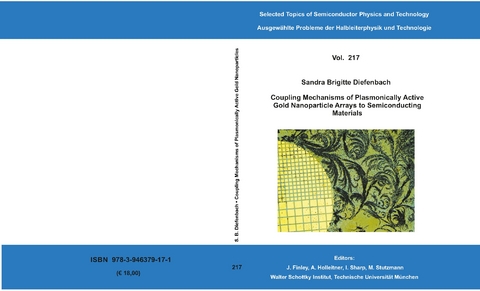
Coupling Mechanisms of Plasmonically Active Gold Nanoparticle Arrays to Semiconducting Materials
Seiten
2018
Verein zur Förderung des Walter Schottky Instituts der Technischen Universität München (Verlag)
978-3-946379-17-1 (ISBN)
Verein zur Förderung des Walter Schottky Instituts der Technischen Universität München (Verlag)
978-3-946379-17-1 (ISBN)
- Keine Verlagsinformationen verfügbar
- Artikel merken
The study of surface plasmons is among the most vibrant fields of research in the last years as plasmonics opens the possibility of capturing and localizing light into a nanoscale volume. Acting as a nano-antenna, plasmonically active gold nanoparticles are already widely used in biomedicine, for example for cancer diagnostics or photothermal therapy. The tunability and sensitivity of the surface plasmon resonance to the dielectric surrounding and the geometry makes plasmonically active gold nanoparticles to excellent candidates for the design of optoelectronic nano-devices.
In this thesis, we study the coupling of plasmons to molecules, semiconductors and collective plasmon excitations. To this end, we investigate the fingerprint of the collective surface plasmon mode of gold nanoparticle arrays regarding their shape and layer number as well as the interactions with a distinct dielectric environment. We find that the anisotropy of the collective surface plasmon mode of ellipsoidal shaped gold nanorods reveals itself in the polarization dependence of the photoconductance. Moreover, we discuss the surface plasmon mode and the transport processes in gold nanoparticle array multilayers. Our findings suggest that gold nanoparticle multilayers in the Coulomb blockade regime can be used in principle as an on-chip temperature sensor due to a temperature sensitive threshold voltage.
A long-term goal, which motivates the investigation of the coupling mechanisms of surface plasmons to semiconducting materials, is an increased efficiency of the photoconversion in photovoltaics and in photocatalytic devices. The idea is that the excitation of surface plasmons in close vicinity to a semiconductor enhances the absorption of light in the semiconducting material due to an increased near-field interaction or by a plasmonically-induced hot electron injection. Here, we disentangle the interaction mechanisms between plasmonically active gold nanoparticle arrays and semiconducting materials. To this end we examine the coupling mechanisms to the conventional semiconductor silicon and expand the experimental scheme to the two-dimensional transition metal dichalcogenide MoS2.
We find that covering a monolayer of MoS2 with a gold nanoparticle array enhances the photoluminescence intensity of the MoS2 excitons by a factor of 10-20 in both resonant and non-resonant excitation to the surface plasmon. Complementary measurements using Raman spectroscopy and spectroscopic imaging ellipsometry indicate the excitation of the collective surface plasmon mode. Kelvin probe force microscopy measurements further reveal a decrease of the work function of the MoS2 upon the coverage with the gold nanoparticle array. We suggest that a lowered quasi-particle bandgap causes the reduced work function, as our findings point towards a constant intrinsic doping level. Finally we introduce an altered far-field emission pattern and an altered phase contrast caused by the increased local density of optical states as possible origins of the increased photoluminescence intensity.
The study of surface plasmons is among the most vibrant fields of research in the last years as plasmonics opens the possibility of capturing and localizing light into a nanoscale volume. Acting as a nano-antenna, plasmonically active gold nanoparticles are already widely used in biomedicine, for example for cancer diagnostics or photothermal therapy. The tunability and sensitivity of the surface plasmon resonance to the dielectric surrounding and the geometry makes plasmonically active gold nanoparticles to excellent candidates for the design of optoelectronic nano-devices.
In this thesis, we study the coupling of plasmons to molecules, semiconductors and collective plasmon excitations. To this end, we investigate the fingerprint of the collective surface plasmon mode of gold nanoparticle arrays regarding their shape and layer number as well as the interactions with a distinct dielectric environment. We find that the anisotropy of the collective surface plasmon mode of ellipsoidal shaped gold nanorods reveals itself in the polarization dependence of the photoconductance. Moreover, we discuss the surface plasmon mode and the transport processes in gold nanoparticle array multilayers. Our findings suggest that gold nanoparticle multilayers in the Coulomb blockade regime can be used in principle as an on-chip temperature sensor due to a temperature sensitive threshold voltage.
A long-term goal, which motivates the investigation of the coupling mechanisms of surface plasmons to semiconducting materials, is an increased efficiency of the photoconversion in photovoltaics and in photocatalytic devices. The idea is that the excitation of surface plasmons in close vicinity to a semiconductor enhances the absorption of light in the semiconducting material due to an increased near-field interaction or by a plasmonically-induced hot electron injection. Here, we disentangle the interaction mechanisms between plasmonically active gold nanoparticle arrays and semiconducting materials. To this end we examine the coupling mechanisms to the conventional semiconductor silicon and expand the experimental scheme to the two-dimensional transition metal dichalcogenide MoS2.
We find that covering a monolayer of MoS2 with a gold nanoparticle array enhances the photoluminescence intensity of the MoS2 excitons by a factor of 10-20 in both resonant and non-resonant excitation to the surface plasmon. Complementary measurements using Raman spectroscopy and spectroscopic imaging ellipsometry indicate the excitation of the collective surface plasmon mode. Kelvin probe force microscopy measurements further reveal a decrease of the work function of the MoS2 upon the coverage with the gold nanoparticle array. We suggest that a lowered quasi-particle bandgap causes the reduced work function, as our findings point towards a constant intrinsic doping level. Finally we introduce an altered far-field emission pattern and an altered phase contrast caused by the increased local density of optical states as possible origins of the increased photoluminescence intensity.
In this thesis, we study the coupling of plasmons to molecules, semiconductors and collective plasmon excitations. To this end, we investigate the fingerprint of the collective surface plasmon mode of gold nanoparticle arrays regarding their shape and layer number as well as the interactions with a distinct dielectric environment. We find that the anisotropy of the collective surface plasmon mode of ellipsoidal shaped gold nanorods reveals itself in the polarization dependence of the photoconductance. Moreover, we discuss the surface plasmon mode and the transport processes in gold nanoparticle array multilayers. Our findings suggest that gold nanoparticle multilayers in the Coulomb blockade regime can be used in principle as an on-chip temperature sensor due to a temperature sensitive threshold voltage.
A long-term goal, which motivates the investigation of the coupling mechanisms of surface plasmons to semiconducting materials, is an increased efficiency of the photoconversion in photovoltaics and in photocatalytic devices. The idea is that the excitation of surface plasmons in close vicinity to a semiconductor enhances the absorption of light in the semiconducting material due to an increased near-field interaction or by a plasmonically-induced hot electron injection. Here, we disentangle the interaction mechanisms between plasmonically active gold nanoparticle arrays and semiconducting materials. To this end we examine the coupling mechanisms to the conventional semiconductor silicon and expand the experimental scheme to the two-dimensional transition metal dichalcogenide MoS2.
We find that covering a monolayer of MoS2 with a gold nanoparticle array enhances the photoluminescence intensity of the MoS2 excitons by a factor of 10-20 in both resonant and non-resonant excitation to the surface plasmon. Complementary measurements using Raman spectroscopy and spectroscopic imaging ellipsometry indicate the excitation of the collective surface plasmon mode. Kelvin probe force microscopy measurements further reveal a decrease of the work function of the MoS2 upon the coverage with the gold nanoparticle array. We suggest that a lowered quasi-particle bandgap causes the reduced work function, as our findings point towards a constant intrinsic doping level. Finally we introduce an altered far-field emission pattern and an altered phase contrast caused by the increased local density of optical states as possible origins of the increased photoluminescence intensity.
The study of surface plasmons is among the most vibrant fields of research in the last years as plasmonics opens the possibility of capturing and localizing light into a nanoscale volume. Acting as a nano-antenna, plasmonically active gold nanoparticles are already widely used in biomedicine, for example for cancer diagnostics or photothermal therapy. The tunability and sensitivity of the surface plasmon resonance to the dielectric surrounding and the geometry makes plasmonically active gold nanoparticles to excellent candidates for the design of optoelectronic nano-devices.
In this thesis, we study the coupling of plasmons to molecules, semiconductors and collective plasmon excitations. To this end, we investigate the fingerprint of the collective surface plasmon mode of gold nanoparticle arrays regarding their shape and layer number as well as the interactions with a distinct dielectric environment. We find that the anisotropy of the collective surface plasmon mode of ellipsoidal shaped gold nanorods reveals itself in the polarization dependence of the photoconductance. Moreover, we discuss the surface plasmon mode and the transport processes in gold nanoparticle array multilayers. Our findings suggest that gold nanoparticle multilayers in the Coulomb blockade regime can be used in principle as an on-chip temperature sensor due to a temperature sensitive threshold voltage.
A long-term goal, which motivates the investigation of the coupling mechanisms of surface plasmons to semiconducting materials, is an increased efficiency of the photoconversion in photovoltaics and in photocatalytic devices. The idea is that the excitation of surface plasmons in close vicinity to a semiconductor enhances the absorption of light in the semiconducting material due to an increased near-field interaction or by a plasmonically-induced hot electron injection. Here, we disentangle the interaction mechanisms between plasmonically active gold nanoparticle arrays and semiconducting materials. To this end we examine the coupling mechanisms to the conventional semiconductor silicon and expand the experimental scheme to the two-dimensional transition metal dichalcogenide MoS2.
We find that covering a monolayer of MoS2 with a gold nanoparticle array enhances the photoluminescence intensity of the MoS2 excitons by a factor of 10-20 in both resonant and non-resonant excitation to the surface plasmon. Complementary measurements using Raman spectroscopy and spectroscopic imaging ellipsometry indicate the excitation of the collective surface plasmon mode. Kelvin probe force microscopy measurements further reveal a decrease of the work function of the MoS2 upon the coverage with the gold nanoparticle array. We suggest that a lowered quasi-particle bandgap causes the reduced work function, as our findings point towards a constant intrinsic doping level. Finally we introduce an altered far-field emission pattern and an altered phase contrast caused by the increased local density of optical states as possible origins of the increased photoluminescence intensity.
| Erscheinungsdatum | 09.01.2019 |
|---|---|
| Sprache | englisch |
| Maße | 150 x 210 mm |
| Themenwelt | Naturwissenschaften ► Physik / Astronomie |
| Schlagworte | Excitons • plasmonics • Transition metal dichalcogenides |
| ISBN-10 | 3-946379-17-6 / 3946379176 |
| ISBN-13 | 978-3-946379-17-1 / 9783946379171 |
| Zustand | Neuware |
| Haben Sie eine Frage zum Produkt? |
Mehr entdecken
aus dem Bereich
aus dem Bereich
von den Werkzeugen über Methoden zum TQM
Buch | Softcover (2024)
Springer Fachmedien (Verlag)
32,99 €
kurz und praktisch - für Ingenieure und Naturwissenschafler
Buch | Softcover (2024)
De Gruyter Oldenbourg (Verlag)
44,95 €


